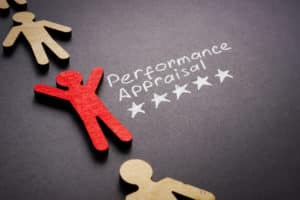As many organisation’s review individual performance and begin setting goals for the current financial year, it’s important to understand how to get the most out of goal setting processes and conversations to increase performance.
Goal setting theory
The premise of goal setting theory assumes that employee behaviour is driven by consciously chosen goals and is very much a cognitive process. The underlying assumption is that both motivation and job performance will be increased if:
- Goals are specific and clear rather than an encouragement to ‘do your best’;
- Goals should stretch the employee, either through learning or performance;
- Goals need to be accepted – participation in goal setting will more likely lead to acceptance; and
- Feedback – objective, immediate and obvious on progress needs to be provided to the employee.
Common issues with goal setting
Goal setting theory is often considered a leading motivational theory, although there are varying perspectives on the relevance and benefits of practical application within organisations.
Setting goals can be beneficial and lead to both employee motivation and job performance (individual, team and organisation), however, as with all approaches there are considerations that need to be made to ensure that the intent aligns with the actual outcomes.
You should consider the following before setting goals:
- Goal setting is often used as the ‘be all and end all’ solution for employees to achieve outcomes with little consideration provided to other dependent and independent variables.
- If goals are too specific, they can narrow an employee’s focus to the extent that it can negatively impact other’s goals or other tasks are overlooked.
- Multiple goals can cause employees to lose focus and not progress in achieving any of the goals
- Risk-taking and unethical behaviour can result if goals are found to be too challenging and employees perceive that there is no alternative to achieve them (as seen with Enron and across the Financial Services Royal Commission.)
- Managers are unable to determine easily when it is appropriate to set a learning goal vs a performance goal, thereby not creating an environment in which the employee can succeed.
- Setting the same goal to multiple employees can result in perceptions of inequity – as it will be challenging for some and not challenging for others – especially if the same reward applies to all.
Effective goal setting
Goal setting can be used to increase both task and contextual performance in organisations. The key is understanding:
- WHY the goals are being set;
- WHAT the goals are trying to achieve (i.e. objectives and outcomes);
- WHO the goals relate to (including accountability and responsibility); and
- WHEN the goals need to be achieved by.
Clarify the purpose
Leaders need to be clear on the purpose of goal setting before implementing goals for employees, and need to understand what will motivate each employee to achieve the expected outcome. This will assist leaders in directing focus and effort for the employee. For example, if an employee does not have the required skills to achieve a challenging performance goal, this can have an impact on their motivation, self-efficacy, and ultimately lead to disengagement. In this instance, it would be better for the leader to set a difficult learning goal, for the employee to gain the skills required, monitor progress, provide feedback and review when necessary prior to setting a challenging performance goal.
Link individual and organisational goals
Effective goal setting can also occur when there is a clear link between divisional, team and individual goals to the organisational strategy. When employees can identify what they do and how they contribute to the larger organisational purpose, it can align with their intrinsic motivators and encourage innovation, creativity and self-actualisation. It is also important to be clear as to what are individual goals, what are team goals and what are divisional goals when these are being set as these will all have differing inputs, outputs and outcomes.
Consider collaborative goals
With the increased focus on organisational culture and employee experience, many organisations are implementing ‘collaborative goals’ to minimise the impact of conflicting goals and metrics, which exist across different business groups. While the intention is creating collaboration and knowledge sharing, typically these goals are set at the highest level – i.e. C-Suite – with the rewards for achieving those goals also at that level. Given that most employees have little say (i.e. no participation) in the goal setting process, measures of success or rewards, they are often less accepting of the goal or motivated to work towards achieving the outcomes and it can be viewed as a meaningless compliance exercise when the goal outcomes are reviewed annually.
Be clear about how performance will be rewarded
The role of the leader is critical in making the links for the employees and the team in terms of how their performance will be rewarded. Where there is confusion on this issue, employees can be unclear on what success looks like, and as a result, if there are monetary implications (i.e. a pay rise or not) and expectations are not met for what they believed to be an appropriate performance, then equity issues can arise. Calibration can go some way to minimising this – i.e. comparing similar goals for similar roles across the organisation in terms of complexity, challenge, etc., but without thought being provided at the initial stages of goal setting, this can also lead to conflict and perceptions of inequity – i.e. one employee has ‘easier/harder goals’ and yet is being rewarded equally for achieving them. Additionally, overlay this with a societal cultural lens and perceptions of what achievement is from a cultural perspective (i.e. West vs East societal approaches) and while there may be no overt signs of disenchantment, this doesn’t mean that it is not there and won’t arise in another situation or context.
Consider ongoing review conversations
In terms of feedback, some organisations have started to move away from the mandatory twice-yearly performance review in recognition that this may not be relevant or useful to all leaders and employees. While there is still an initial goal-setting session at the start of the year and a formal review at the end, leaders review progress and provide feedback on an ongoing basis throughout the year. Often business priorities change, resulting in goals changing and this more agile approach allows leaders to discuss and modify goals as required in line with changed business outcomes. In addition, leaders have regular meetings with both their direct reports and ‘leader once removed’ meetings to understand team performance and effectiveness more holistically and make adjustments based on team capability as needed.
Goal setting should be part of a much broader organisational system of work, and other variables – i.e. job design, remuneration, development, ability etc. also need to be taken into consideration. Relying on goal setting alone to achieve success or predict motivation and job performance is not enough to achieve the result being sought.

















